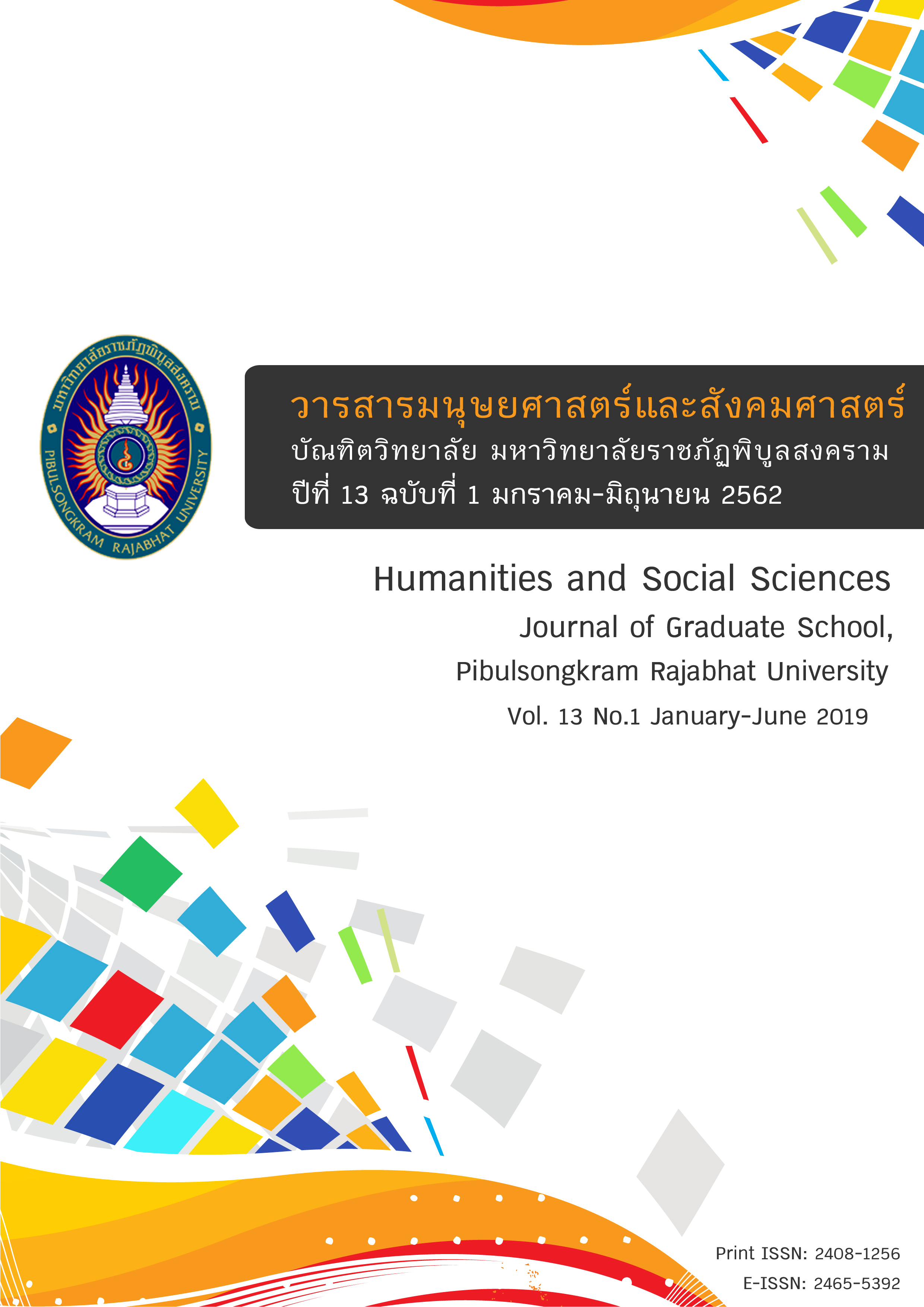The Development of a Local Dramatic Art Training Curriculum Entitled “The Charm of Noenmaprang” for a Junior High School Thai Dramatic Art Association
Keywords:
Local Dramatic Art, The Charm of Noenmaprang Training Curriculum, Junior High School Thai Dramatic Art AssociationAbstract
The purpose of this research was to establish and check the quality of curriculum to experiment and assess of a local dramatic art training curriculum entitled “The Charm of Noenmaprang” to assess practical dramatic art skills and to study students’ satisfaction in local dramatic art training curriculum entitled “The Charm of Noenmaprang”. The experimental research with one group posttest design. The samples were 15 students Junior High School Thai Dramatic Art Association at Bannoenmaprang School, Phitsanulok Primary Educational Service Area Office 2. The research found that:
- The construct and check of the curriculum quality to experiment and assess of a local dramatic art training curriculum entitled “The Charm of Noenmaprang”, the researcher did it according to Bata’s curriculum development. The subject consisted of 5 unit summaries: Unit 1. My home Noenmaprang, Unit 2. The backround of local dramatic art training curriculum entitled “The Charm of Noenmaprang”, Unit 3. The practical dramatic art and body language skills, Unit 4. The practical dramatic art skills of “The Charm of Noenmaprang” song, Unit 5. The standing design. There are 11 sub activities in 6 day training with 3 hours a day totally 18 hours. This course is checked in terms of quality of curriculum by 4 academic experts. The results showed that the development of curriculum had accuracy, propriety, feasibility, and utility. Overall it was at the highest level and when considered by each aspect ordering from the highest to the lowest they were utility, propriety, accuracy, and feasibility.
- The study from experiment of a local dramatic art training curriculum entitled “The Charm of Noenmaprang” for a Junior High School Thai Dramatic Art Association overall, it was found that the practical skills were at a high level. When considered by each aspect, it was found that the practical skills at a high level were practical propriety to the meaning of song lyrics, costume, performance element and the practical skills at low level were beauty in unison.
- The study of satisfaction in terms of contents, activities organizing, place and time, expected results and instillation of their positive desirable characteristics on avidity for learning and cherishing Thai-ness overall, the satisfaction was at the highest level. When considered by each aspect, it was found that the highest satisfaction was instillation of their positive desirable characteristics on avidity for learning and cherishing Thai-ness. Then expected utility, the activity organizing, place and time were at the highest levels. The least satisfaction was the contents.
References
บุญชม ศรีสะอาด. (2547). วิธีการทางสถิติสำหรับการวิจัย (พิมพ์ครั้งที่ 7). กรุงเทพฯ: สุวีรียาสาส์น.
พิชญา สังข์เงิน, พิไรพร ถิ่นเครือจีน, และศิริวรรณ สมสกุล. (2552). การพัฒนาหลักสูตรกิจกรรมชุมนุมนาฏศิลป์เรื่องฟ้อนทอผ้าป่าแดง สำหรับนักเรียนช่วงชั้นที่ 3. พิจิตร: โรงเรียนตะพานหิน.
พิสุทธิ์ แดงเอม. (2552). การพัฒนาหลักสูตรท้องถิ่น เรื่องระบำชอง กลุ่มสาระวิชาชีพเฉพาะนาฏศิลป์ไทย สำหรับนักเรียนชั้นมัธยมศึกษาปีที่ 1. จันทบุรี: วิทยาลัยนาฏศิลป์จันทบุรี.
เรณู โกสินานนท์. (2535). รำไทย. กรุงเทพฯ: องค์การค้าของคุรุสภา.
โรงเรียนบ้านเนินมะปราง. (2558). รายงานการประชุมคณะครูและบุคลากรทางการศึกษา ครั้งที่ 1/2558. พิษณุโลก: โรงเรียนบ้านเนินมะปราง.
ศรัณยา โพธิ์ปาน. (2557). การพัฒนาหลักสูตรรายวิชาเพิ่มเติมนาฏศิลป์ไทย (โขน) กลุ่มสาระการเรียนรู้ศิลปะ สำหรับนักเรียนชั้นมัธยมศึกษาปีที่ 3. สุพรรณบุรี: โรงเรียนดอนคาวิทยา.
Taba, H. (1962). Curriculum Development Theory and Practice. New York : Harcourt, Brace and World.
Downloads
Published
How to Cite
Issue
Section
License
Any articles or comments appearing in the Journal of Humanities and Social Sciences, Rajabhat Phibulsongkram University, are the intellectual property of the authors, and do not necessarily reflect the views of the editorial board. Published articles are copyrighted by the Journal of Humanities and Social Sciences, Rajabhat Phibulsongkram University.








